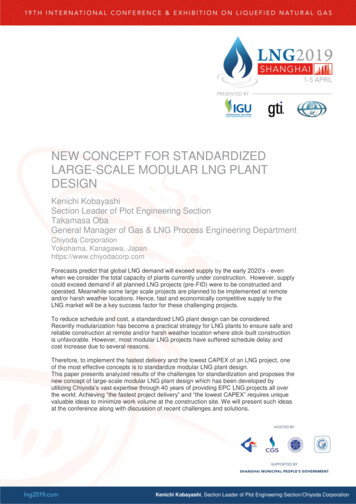
Transcription
NEW CONCEPT FOR STANDARDIZEDLARGE-SCALE MODULAR LNG PLANTDESIGNKenichi KobayashiSection Leader of Plot Engineering SectionTakamasa ObaGeneral Manager of Gas & LNG Process Engineering DepartmentChiyoda CorporationYokohama, Kanagawa, Japanhttps://www.chiyodacorp.comForecasts predict that global LNG demand will exceed supply by the early 2020’s - evenwhen we consider the total capacity of plants currently under construction. However, supplycould exceed demand if all planned LNG projects (pre-FID) were to be constructed andoperated. Meanwhile some large scale projects are planned to be implemented at remoteand/or harsh weather locations. Hence, fast and economically competitive supply to theLNG market will be a key success factor for these challenging projects.To reduce schedule and cost, a standardized LNG plant design can be considered.Recently modularization has become a practical strategy for LNG plants to ensure safe andreliable construction at remote and/or harsh weather location where stick-built constructionis unfavorable. However, most modular LNG projects have suffered schedule delay andcost increase due to several reasons.Therefore, to implement the fastest delivery and the lowest CAPEX of an LNG project, oneof the most effective concepts is to standardize modular LNG plant design.This paper presents analyzed results of the challenges for standardization and proposes thenew concept of large-scale modular LNG plant design which has been developed byutilizing Chiyoda’s vast expertise through 40 years of providing EPC LNG projects all overthe world. Achieving “the fastest project delivery” and “the lowest CAPEX” requires uniquevaluable ideas to minimize work volume at the construction site. We will present such ideasat the conference along with discussion of recent challenges and solutions.Kenichi Kobayashi, Section Leader of Plot Engineering Section/Chiyoda Corporation
INTRODUCTIONIt is currently estimated that the global population will rise to over 9.8 billion by 2050. With this increase, it isexplicit that energy demand will also increase. Furthermore, history has shown that the increase in energy demandexceeds the incremental increase in global population. Although the utilization of renewable sources of energy willsteadily increase, fossil fuels will continue to be major source of global energy. Among the fossil fuels, natural gasand LNG will continue to play a vital role in countering global warming.Forecasts predict that global LNG demand will exceed supply by the early 2020’s - even when we consider thetotal capacity of plants currently under Engineering, Procurement and Construction (EPC). However, supply couldexceed demand if all planned LNG projects were to be constructed and operated.Meanwhile some large scale projects are planned to be implemented at remote and/or harsh weather locations.In addition, a lack of skilled workers is manifesting in some countries due to a rush of construction.For these severe conditions, fast and economically competitive supply to the LNG market will be a key successfactor to realize projects.Chiyoda Corporation introduced CHIYODA LNG-X R in the LNG 18 conference to achieve the lowest CAPEX andfastest project delivery for stick built LNG projects. Now Chiyoda Corporation has developed the modular version ofCHIYODA LNG-X R to cope with challenging conditions mentioned above.NEW CONCEPTFor optimizing modularized LNG plant, the following new concepts are adopted which were inherited fromCHIYODA LNG-X R concepts and further expanded in consideration of the special nature of a modularized plant;1) Ready-designed blockIn general, LNG process train consists of several units such as inlet unit, acid gas removal unit, dehydrationunit, mercury removal unit, heavy hydrocarbon removal unit, and liquefaction unit. Although the design ofrespective units is not completely the same for every project because of client’s policy or preference, thebasis of design is similar. Each unit can therefore be pre-designed by the experienced contractor as “Readydesigned blocks” based on the philosophy of safe operation and cost effectiveness. The basic design of theLNG train can be completed within a short time period as shown in Figure 1 just by connection of theseblocks. Using this concept, although the LNG production or the operation efficiency may not be maximized,cost and schedule can be reduced.
Source: Standardization of LNG Plant Design Based on a New Concept, Toshiya Momose, Chiyoda Corporation, LNG18Figure 1: Ready-designed Block Concept2) Contractor standard job specificationSpecifications prepared by the experienced contractor are to be applied to standardized LNG plant design inlieu of a client’s individual specifications. The standardized design might deviate from the client’sspecifications, however no major problem is expected for project execution since the specifications preparedby the contractor are developed based on the vast experience of contractor and assure the necessary andsufficient safety and operability of plant.Chiyoda standard job specifications are applied to the modular version of CHIYODA LNG-X R3) Eliminating the pre-requisite works at the early engineering stageReference is made to Figure 2 below which compares four example project schedules.The EPC bidding stage in the “Dual FEED & EPC Contract” schedule can be reduced as EPC costestimation is executed on the basis of each bidder’s design. If the client utilizes an alliance contract for FEEDdesign, the intermediate stages from pre-FEED to FEED such as FEED bidding, bid evaluation and theFEED contract can be eliminated. At the early stage of a project (pre-FEED), if a client decides to adopt thestandardized design and the same contractor executes through FEED and EPC, the contractor can offer thefastest project delivery.
Source: Standardization of LNG Plant Design Based on a New Concept, Toshiya Momose, Chiyoda Corporation, LNG18Figure 2: Project Schedule ComparisonIn addition, the new concept applied to the modular version of CHIYODA LNG-X R to achieve the lowest CAPEXand the fastest project delivery is as follows;4) Minimum work volume at construction siteA)Minimization of welding work volume around main refrigerant compressorEven though modular construction is applied, there is much site welding work for hook-up between modulesand stick built items.In past modularized projects, it was common to consume many man hours around the main refrigerantcompressor. Therefore welding work volume (dia-inch, hereinafter DI) at site related to main refrigerantcompressors per one process train were re-evaluated as shown in Table 1 below;Note *1) Dia inch is calculated based on single weld hook-up between Pre-Assembled Rack (PAR) and PAR, double weldhook-up between PAR and Pre-Assembled Unit (PAU).Table 1: Comparison of Welding Work Volume at Site
It is confirmed that site welding work volume related to main refrigerant compressors is approximately 50% oftotal site work volume.Therefore the main focus area to minimize the welding site work volume is around the main refrigerantcompressors.How can we shift welding site work volume around main refrigerant compressor to the module yard?Of course, if the components of the main refrigerant compressors are delivered to the yard and assembledtogether with PAU, welding site work volume can be reduced significantly, however we noted, in this case,total project schedule would be extended. Consequently the fastest project delivery could not be achieved.If the components of the main refrigerant compressor are assembled on a common skid at vendor shop,some of the work around main refrigerant compressor can be reduced, however the majority of the weldingsite work for refrigerant piping is still left.As a result of case study, it was concluded to apply the following solutions;-Assemble the main refrigerant compressors components on the common skid-Deliver the common skid to site and integrated into PAUNote *2) Air-intake duct and exhaust stack will be installed after skidding.Figure 3: Main Refrigerant Compressor Installation Sequence.
Figure 4: Gas Turbine Engine and Compressor Rotor Change-outB)Layout optimizationIn past modularized projects, piping hook-up work volume between PAR and PAR were approximately 3times larger comparing to the one between PAU and PAR, since there are many large bore straight pipes inPAR which do not pass through the PAU. Furthermore, the number of joint locations between PAU and PARwere 4 times larger compared to those between PAR and PAR.Based on past project experience, the following measures are adopted in order to reduce site welding workvolume;-PAR is as long as practical to minimize number of joint locations between PARs which has large sitewelding work volume.-PAUs are integrated with PARs as much as practical to reduce the number of joint locations.Figure 5: PAU/PAR integrated module concept
This is achieved by optimizing the layout and targeting a minimum number of connections. We have revisedthe conventional “fishbone” layout by placing PAUs on both sides of a main straight pipe rack.C)Minimize electrical and instrument workIn order to minimize cable laying work at site, following concepts are applied;-Install Local Electrical Room (LER) on each PAU and PAR-Install Local Instrument Room (LIR) on each PAU and PAR-Perform pre-commissioning work at module yardFigure 6: LER/LIR mounting on module conceptSTANDARDIZED LARGE-SCALE MODULAR LNG PLANT DESIGNChiyoda Corporation has developed a standardized large-scale modular LNG package, “CHIYODA LNG-XmTMJapan ”, using the new standardization concepts described above and developed from Chiyoda Corporation’sunparalleled expertise and experience in global LNG plant engineering and construction. This concept will minimizesite work and optimize the “Plug & Play” model.CHIYODA LNG-Xm JapanTMhas been developed on the following basis;
Design Package Capacity: 7 Million Tonnes Per Annum. (MTPA) at cold climate region Liquefaction Process: Propane Pre-cooled Mixed Refrigerant Process Refrigerant Compressor Driver: Trent-60 DLE or LM6000PF x 4 (2 strings) Cooling: Air cooling Specification: Chiyoda Standard Job SpecificationCHIYODA LNG-Xm JapanTM derives its name from its module layout resembling the Japanese archipelago.Figure 7: Overview of CHIYODA LNG-Xm JapanTMThrough the 3D model development adopting the concepts mentioned above, site work volume for pipe weldingand cable laying has been compared to a past project which applied conventional measures. The results areshown in Figure 8;
Note *3) Comparison in in-house data for one LNG train3Figure 8: Typical site work volume reduction when applying the large scale modular concept*CONCLUSIONThe importance of LNG as a source of energy will continue to grow in response to escalating global clean energydemand. There are many proposed new LNG facilities but only the most competitive of those projects currentlyunder planning stage will be realized. Consequently “the lowest CAPEX” and “the fastest project delivery” are keycriteria to realize successful future LNG projects. Design standardization with Chiyoda’s new “large scalemodularization” concept is on essential element to achieve these two vital targets.As the No. 1 LNG contractor, Chiyoda Corporation will continue to support clients and contribute to the realizationof successful LNG projects.ACKNOWLEDGEMENTSWe would like to thank Takeshi Kaji for supporting concept development by establishing the 3D model. Hisunconventional ideas and diligence form the basis of the standardized modular package CHIYODA LNG-XmTMJapan .REFERENCE[1] Standardization of LNG Plant Design Based on a New Concept, Toshiya Momose, Chiyoda Corporation,LNG18
of the most effective concepts is to standardize modular LNG plant design. This paper presents analyzed results of the challenges for standardization and proposes the new concept of large-scale modular LNG plant design which has been developed by utilizing Chiyoda's vast expertise through 40 years of providing EPC LNG projects all over the world.











